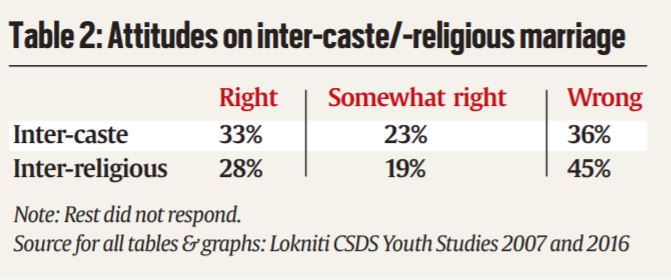Lokniti-CSDS Youth Studies in 2016 and 2007 show the proportion of married youth decreased by eight percentage points from 55% In 2007 to 47% in 2016 .
As norms and values around marriage and family life change, the Indian youth too are being influenced by recent trends. Compared to a decade ago, youth are now marrying later in life. Lokniti-CSDS Youth Studies in 2016 and 2007 show the proportion of married youth decreased by eight percentage points from 55% In 2007 to 47% in 2016 .
As one would expect, the data highlight that a much higher share of young men were unmarried (61%) compared to women (41%) (Table 1). Educational attainment too is an important factor associated with marriage. One observes a decline in the proportion of married youth with successive levels of education
(Figure 1).
Marital preferences
In an age of online dating, growth of social networking and matrimonial sites, arranged marriages are still a preferred choice: 84% of the married youth in 2016 said their marriage was decided by families and only 6% reported self-choice (Figure 2).
Unmarried youth too showed an inclination towards arranged marriages with 50% saying they would opt for this kind of marriage. Only 12% said they would opt for self-choice marriage. Surprisingly, the 2016 study indicates that a mere 3% of youth had placed a matrimonial advertisement.
The study also showed that 31% of the youth said their parents will have or had a lot of influence on their marriage decision. This influence was greater for women (35%) than men (28%). Moreover, data from a recent study, ‘Politics and Society between Election’, show there is some change in attitudes — if not in practice — when it comes to decision-making for women in marriage: 72 % support women’s say in when to get married and 74 % in whom to marry.
There has been an attitude shift on the importance of marriage with an increase in acceptance of being single. Though close to 5 in 10 Indian youth said it is important to get married, this is much lower than 8 in 10 a decade ago (Figure 3, above). Barring non-literates, all other groups were found to be over twice more likely to express this sentiment than they were a decade ago.
Newsletter | Click to get the day’s best explainers in your inbox
Caste & religion
The Youth Study 2016 shows that marriage across caste and religion is still not accepted in an arranged marriage set-up (Table 2). Among the married youth, very few had opted for inter-caste (4%) or marriage outside their religion (3%). These were more prominent among love marriages (inter-caste 34%; inter-religious 12 %). However, the study showed that its acceptance was much higher than what was in practice. One notices an upward trend in acceptance for inter-caste marriages, from 31% in 2007 to 56% in 2016.
On the contrary, the acceptance of inter-religious marriage is much lower, with 47% approving of it and 45% considering it wrong. Youth who had an arranged marriage displayed more resistance towards the idea of inter-caste and inter-religious marriages than those whose marriage had been self-arranged.
Less than a quarter of youth consider love affair between two boys or two girls as right (24% and 26% respectively). Over half 53%) in 2016 were opposed to dating before marriage, but this too has declined from 2007 (60%). However, 67% youth consider the idea of live-in before marriage wrong.
Life partner consideration
When it comes to characteristics one seeks in one’s life partner, the youth seem rather vague. Close to half the respondents did not respond to the question. Among those who responded, 14% said their biggest consideration was that the person should have a good nature and simple personality; 8% gave priority to education and 5% each to being respectful and understanding and being traditional, cultured and having moral values. Another 5% said looks and skin colour were their biggest consideration. The spouse’s profession and salary were important to about 4%.
A higher proportion of men gave primacy to qualities such as education and looks, especially skin colour.
Young women, on the other hand, were more likely to give importance to profession and salary compared to young men. On most other parameters, there was no striking difference between men and women.
To sum up, the youth are marrying late; the institution of arranged marriage is still intact; marrying across caste or religion is still not much accepted; and overall, attitudes to marriage remain within the boundaries of traditional thinking.
Source: Read Full Article






